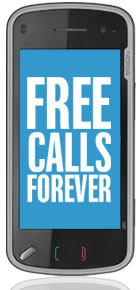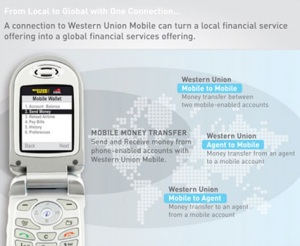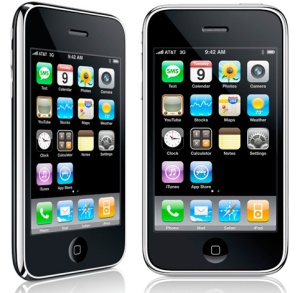Archive
Free Calls Forever: Three (UK) Launch Nokia N97 With Skype!
(UK) “It’s the new flagship smartphone that’s got everyone talking and it’s coming to 3 – the only network in the UK currently promoting free Skype on the Nokia N97, as well as most of their handset range.

Announcing itself as the world’s most advanced mobile computer, the N97 isn’t afraid to make big shouts, and now it has arrived. 3 is the first operator to embrace free Skype-to-Skype calling and IM on the phone via the Skype on 3 application.
As with all of 3’s Skype-enabled phones, making Skype-to-Skype calls on N97s using this application in the UK won’t cost consumers a penny. The phone will be available on contract from £35 a month, with voicemail and 300 minutes/texts. Internet can be added for £5 a month…”
The news was picked from & continues @ http://www.3g.co.uk/PR/June2009/Three_Launch_Nokia_N97_With_Skype.html
Another Mobile Wallet news: Western Union Mobile to hit global
“…
The Western Union Co., together with its Vigo and Orlandi Valuta-branded money transfer services, provides consumers with ways to send and receive money worldwide, as well as send payments and buy money orders.
Western Union entered the mobile finance space in the second quarter of 2008, with an endorsement for a global pilot program by the GSM Association, a global trade association representing more than 750 mobile carriers worldwide.

The Western Union Digital Vendor Program is open to mobile finance platform vendors who have successfully deployed a mobile money offering.
Certified vendors agree to maintain current version control against the Western Union money transfer service interface…
…Successful mobile money service offerings are typically deployed on a single-country basis and include three service providers working together in a single mobile finance ecosystem, according to Western Union.
Participants in this ecosystem include carriers, financial institutions and mobile platform providers.
Western Union connects into this ecosystem by providing money-transfer capabilities.
The company is certifying mobile platform vendors to reduce integration costs and accelerate go-to-market activities for banks and carriers by creating standard technical deployments.
Once a bank or carrier contracts with Western Union to activate its mobile money transfer service, its consumers will be able to send and/or receive money through Western Union’s global money transfer system, connected to more than 334,000 agent locations in 200 countries and territories…”
The article is picked from & continues @ http://www.mobilemarketer.com/cms/news/banking-payments/3564.html
(note: mobile wallet, mobile commerce, mobile banking… an important space to watch… jr)
Best Australian iPhone 3GS Deals

“…Best deal on a 24-month contract: Vodafone’s $69 deal for the 16GB model offers 1GB of data and $400 of calls. On launch day, Optus announced a $10 rebate on its $79 plan which means it offers more calls and texts — but the fact you’ll still have to pay the tethering charge makes it a pricier deal unless you really just want the iPhone to be a phone.
Best deal on a 12-month contract: Optus was originally the only provider offering a 12-month contract, but Vodafone has also added that option, albeit with high handset charges. hard to pick here, though again tethering would be an issue for Optus users.
Best deal for an outright buy: If you can get to an Apple store, then its apparent prices of $879 for the 16GB model or $1040 for the 32GB will be hard to beat.
Best telco for tethering: Vodafone is the best option if tethering is a feature you want to use regularly as (opposed to occasionally) — Optus’ tethering charge puts it out of contention and Telstra’s data allowance is way too stingy…”
Picked from: http://www.lifehacker.com.au/2009/06/best-australian-iphone-3gs-deals/
Worlds First MOBILE Augmented Reality Browser
“SPRXmobile has created what they claim is the world’s first augmented reality browser for mobile phones, named Layar. The program, which will only be available for Android phones at the moment, displays real-time digital information on top of the real-world locations it sees through a mobile device’s camera. Layar does not work by using any kind of image or object recognition, but rather through a combination of camera, compass and GPS.”
SPRXmobile explains:
“Layar is derived from location based services and works on mobile phones that include a camera, GPS and a compass. Layar is first avaliable for handsets with the Android operating system (the G1 and HTC Magic). It works as follows: Starting up the Layar application automatically activates the camera. The embedded GPS automatically knows the location of the phone and the compass determines in which direction the phone is facing. Each partner provides a set of location coordinates with relevant information which forms a digital layer. By tapping the side of the screen the user easily switches between layers. This makes Layar a new type of browser which combines digital and reality, which offers an augmented view of the world.”
picked from & continues @ http://www.psfk.com/
Ford revs up mobile campaign for 2010 Mustang launch
“Ford revs up mobile campaign for 2010 Mustang launch Ford Motor Co. has rolled out a multi-faceted mobile campaign that includes branded content and mobile advertising to promote the launch of the 2010 Mustang.”

Ad-supported mobile entertainment site Myxer’s new Mobile Media Storefront showcases Ford-branded content and the user-generated content related to Mustang in a custom-designed storefront, available on both the wired and mobile Web. The Ford campaign also includes mobile advertising…”
Picked from & continues @ http://www.mobilemarketer.com/cms/news/advertising/3543.html
Gartner’s eight mobile technologies to watch in 2009 and 2010
1. Bluetooth 3.0 —The Bluetooth 3.0 specification will be released in 2009 (at which point its feature set will be frozen), with devices starting to arrive around 2010. Bluetooth 3.0 will likely include features such as ultra-low-power mode that will enable new devices, such as peripherals and sensors, and new applications, such as health monitoring. Bluetooth originated as a set of protocols operating over a single wireless bearer technology. Bluetooth 3.0 is intended to support three bearers: “classic” Bluetooth, Wi-Fi and ultrawideband (UWB). It’s possible that more bearers will be supported in the future. Wi-Fi is likely to be a more important supplementary bearer than UWB in the short term, because of its broad availability. Wi-Fi will allow high-end phones to rapidly transfer large volumes of data.
2. Mobile User Interfaces (UIs) — UIs have a major effect on device usability and supportability. They will also be an area of intense competition in 2009 and 2010, with manufacturers using UIs to differentiate their handsets and platforms. New and more-diverse UIs will complicate the development and support of business-to-employee (B2E) and business-to-consumer (B2C) applications. Organizations should expect more user demands for support of specific device models driven by interface preferences. Companies should also expect consumer interfaces to drive new expectations of application behavior and performance. Better interfaces will make the mobile Web more accessible on small devices, and will be a better channel to customers and employees.
3. Location Sensing — Location awareness makes mobile applications more powerful and useful; in the future, location will be a key component of contextual applications. Location sensing will also enhance systems, such as mobile presence and mobile social networking. The growing maturity of on-campus location sensing using Wi-Fi opens up a range of new applications exploiting the location of equipment or people. Organizations delivering business or consumer applications should explore the potential of location sensing; however, exploiting it may create new privacy and security challenges.
4. 802.11n — 802.11n boosts Wi-Fi data rates to between 100 Mbps and 300 Mbps, and the multiple-input, multiple-output technology used by 802.11n offers the potential for better coverage in some situations. 802.11n is likely to be a long-lived standard that will define Wi-Fi performance for several years. High-speed Wi-Fi is desirable to stream media around the home and office. From an organizational perspective, 802.11n is disruptive; it’s complex to configure, and is a “rip and replace” technology that requires new access points, new client wireless interfaces, new backbone networks and a new power over Ethernet standard. However, 802.11n is the first Wi-Fi technology to offer performance on a par with the 100 Mbps Ethernet commonly used for wired connections to office PCs. It is, therefore, an enabler for the all-wireless office, and should be considered by companies equipping new offices or replacing older 802.11a/b/g systems in 2009 and 2010.
5. Display Technologies — Displays constrain many characteristics of both mobile devices and applications. During 2009 and 2010, several new display technologies will impact the marketplace, including active pixel displays, passive displays and pico projectors. Pico projectors enable new mobile use cases (for example, instant presentations projected on a desktop to display information in a brief, face-to-face sales meeting). Battery life improvements are welcome for any user. Good off-axis viewing enables images and information to be shared more easily. Passive displays in devices, such as e-book readers, offer new ways to distribute and consume documents. Display technology will also become an important differentiator and a user selection criterion.
6. Mobile Web and Widgets — The mobile Web is emerging as a low-cost way to deliver simple mobile applications to a range of devices. It has some limitations that will not be addressed by 2010 (for example, there will be no universal standards for browser access to handset services, such as the camera or GPS). However, the mobile Web offers a compelling total cost of ownership (TCO) advantage over thick-client applications. Widgets (small mobile Web applets) are supported by many mobile browsers, and provide a way to stream simple feeds to handsets and small screens. Mobile Web applications will be a part of most B2C mobile strategies. Thin-client applications are also emerging as a practical solution to on-campus enterprise applications using Wi-Fi or cellular connections.
7. Cellular Broadband — Wireless broadband exploded in 2008, driven by the availability of technologies such as high-speed downlink packet access and high-speed uplink packet access, combined with attractive pricing from cellular operators. The performance of high-speed packet access (HSPA) provides a megabit or two of bandwidth in uplink and downlink directions, and often more. In many regions, HSPA provides adequate connectivity to replace Wi-Fi “hot spots,” and the availability of mature chipsets enables organizations to purchase laptops with built-in cellular modules that provide superior performance to add-on cards or dongles.
8. Near Field Communication (NFC) — NFC provides a simple and secure way for handsets to communicate over distances of a centimeter or two. NFC is emerging as a leading standard for applications such as mobile payment, with successful trials conducted in several countries. It also has wider applications, such as “touch to exchange information” (for example, to transfer an image from a handset to a digital photo frame, or for a handset to pick up a virtual discount voucher). Gartner does not expect much of the NFC payment or other activities to become common, even by 2010, in mature markets, such as Western Europe and the U.S. NFC is likely to become important sooner in emerging markets, with some deployments starting by 2010.